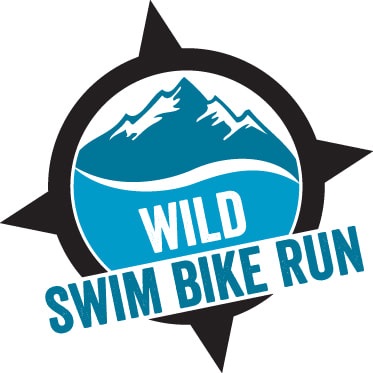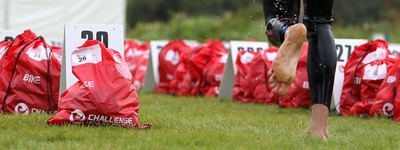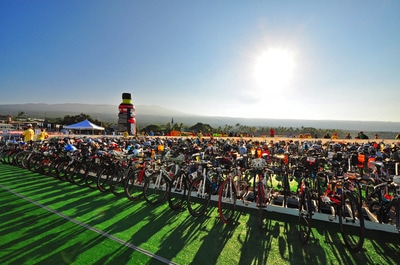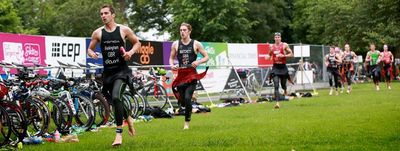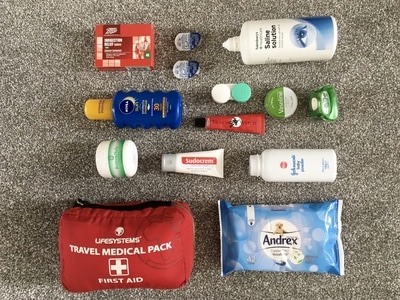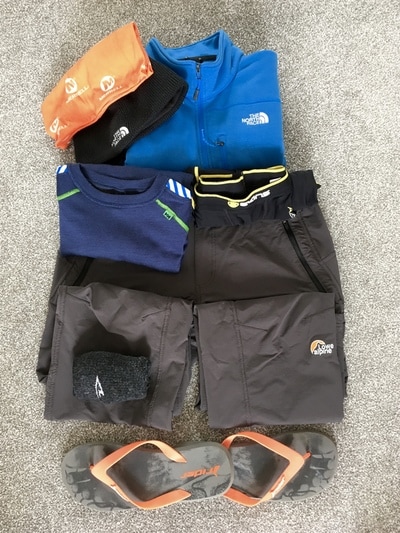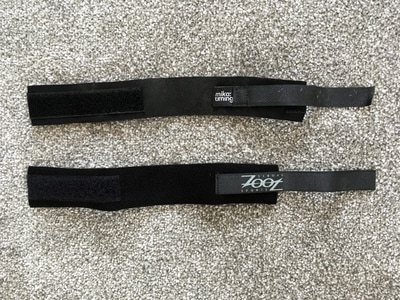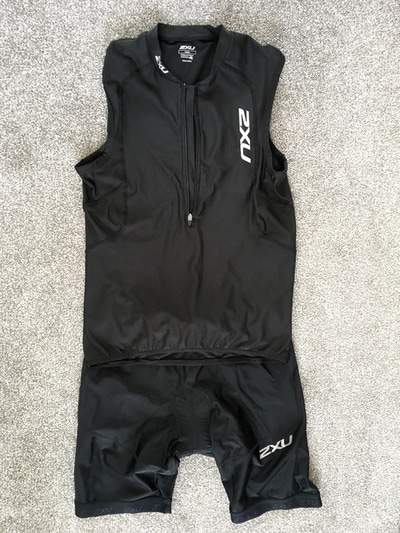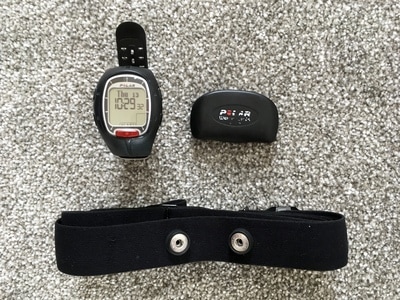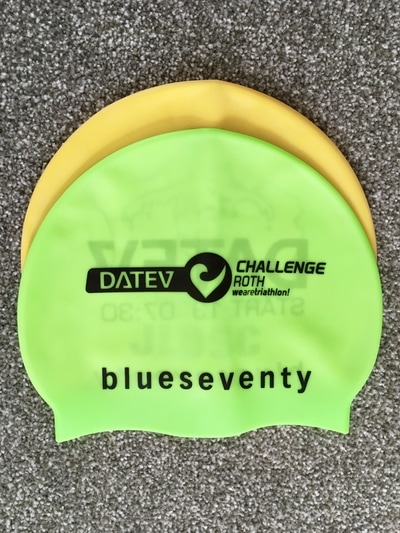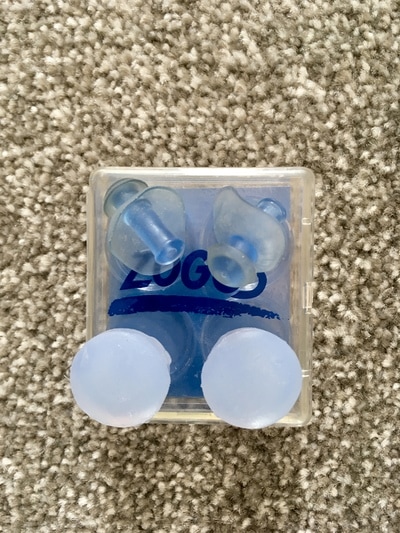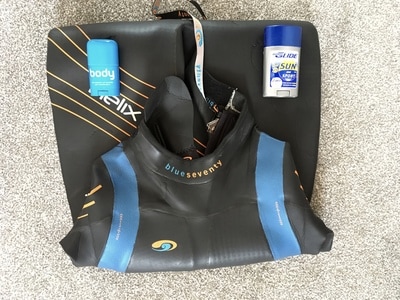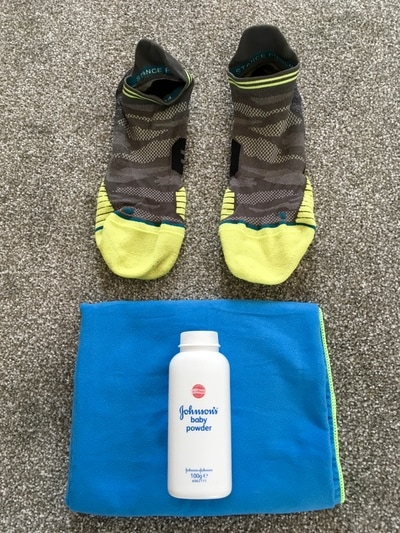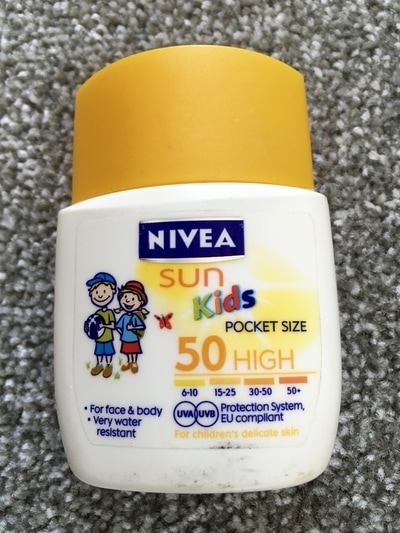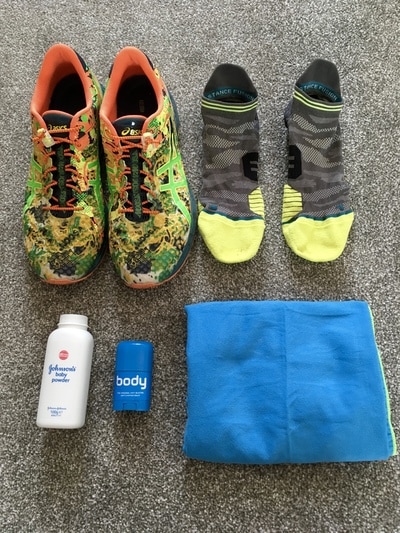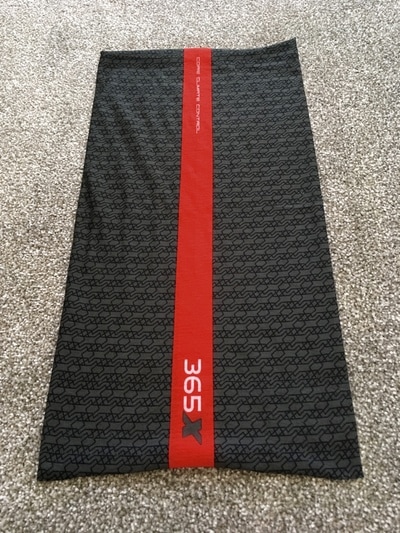What kit and why?
There is an ocean of triathlon equipment available on the market, however, lots of the kit and equipment used as a swimmer, cyclist and runner will cross over effectively. In this section kit and equipment has been grouped as per its use during the day and race.
Once you have identified the kit and equipment that works for you, get it organised! A triathlon or multi-sports race consisits of a series of phases requiring different nutrition, clothing and equipment requirements. It is critical to manage and organise this kit/equipment ensuring the best possible outcome for you and kit on hand when required.
Transitions and Transition Areas
Below are a couple of photos of transition bags and areas. There is also a transition schematic for a Challenge race demonstrating the layout and flow. It's important to spend a bit of time ensuring that your transitions are planned, organised and well executed. Efficient transitions can save minutes in a race.
Important note: When you have dropped your bags off and racked up your bike. Walk through transitions committing to memory the most efficient route to your kit and its location. Use difficult to miss reference points such as a distinctive tree, sponsors advert board etc to trigger your memory and guide you onto your kit and bike.
Once you have identified the kit and equipment that works for you, get it organised! A triathlon or multi-sports race consisits of a series of phases requiring different nutrition, clothing and equipment requirements. It is critical to manage and organise this kit/equipment ensuring the best possible outcome for you and kit on hand when required.
Transitions and Transition Areas
Below are a couple of photos of transition bags and areas. There is also a transition schematic for a Challenge race demonstrating the layout and flow. It's important to spend a bit of time ensuring that your transitions are planned, organised and well executed. Efficient transitions can save minutes in a race.
Important note: When you have dropped your bags off and racked up your bike. Walk through transitions committing to memory the most efficient route to your kit and its location. Use difficult to miss reference points such as a distinctive tree, sponsors advert board etc to trigger your memory and guide you onto your kit and bike.
Pre-Race & Recovery Kit
- Triathlon Bag - You don't need a triathlon specific bag but most available on the market have well laid out organisational pockets including a wet/dry section. A holdall with rucksack style straps combined with a few canoe bags and ziplock bags can be just as effective and cheaper.
- Pre-Race Clothing - If you have a support crew or are parked, accomodated close to the start line you can wear as many changes of clothing as you like throughout the day. If you have to be more compact it's worth wearing the same clothes pre and post race.
- Post-Race Clothing - Normally something warm, comfortable and easy to put on and take off is suitable.
- Compression Clothing - We have tried compression leggings and they do feel like they make a difference post event. There is alot of medical research backing the technology, we are always sceptical about products of this nature but in our experience they have helped during recovery.
- Footwear - Its important that you have comfortable footwear pre and post race. Your feet will have been through the mill during the race and will have swollen. A shoe or flip flop that is easy to get on and off well make a significant difference to your overall comfort. Equally prior to the swim its important to protect your feet, buy some sacrificial flip flops you can wear to the waters edge if the swim entry area isn't covered.
- First Aid Kit - Use a first aid kit with additional dressings for blisters and abrasions. Also carry some electrolyte powders for dehydration, immodium for diarrhoea and ibuprofen as a general painkiller and anti-inflammatory.
- Toiletries - Sunscreen, talcum powder, toilet wipes, medication, ibuprofen, contact lens & fluid, sudacream, chamois cream and anything else you might need pre-post race.
- Head Torch - Races can often start in the darkness. Whilst the transition areas are sometimes floodlit it won't illunimate the inside of your bag, or the floor in the event you drop something.
- Nutrition and Fluids - Important to keep nibbling and sipping pre-race, during and after with a recovery snack or drink.
- Neoprene Glue - In the event you have a pre race disaster with your wetsuit.
General Race Kit
- Triathlon Suit - Worn under your neoprene suit during the swim. For those who find the triathlon suit exposes the figure too much you can mix it up with tri shorts and then a combination of tri-top, cycle top or run top. You can change clothing through transitions to cater for the different storage options you may find useful. Equally if you find that 180km in the saddle is crippling some athletes wear an additonal pair of tri or cycling shorts for comfort.
- Timer Chip Strap - You normally recieve one of these as part of the race kit but some people prefer having their own, never hurts to have a spare.
- HR Monitor - Most brands work in water. Remember to turn it on at the gun and through transitions if you want splits.
- Salt Tablets - We have salt tablets squirreled away all over the place. Darroch has had bad cramps at a couple of events, almost a showstopper for chasing a PB. Having them spread throughout your kit will prompt you to take them throughout the day, they definitely help stave off cramp.
Swim Kit
- Nutrition - Constantly nibble pre-race, carbohydrate gels and muesli bars work well.
- Swim Cap - Keep a couple as you may wish to wear an extra in colder water and for pre-race course swims. Remember that your race issue cap is worn on the outside.
- Neoprene Hat - In the event that the water is cold during pre and race swims.
- Goggles - Take a spare set of goggles. Take some fairy liquid or demisting product aswell.
- Ear Plugs - Take a spare set as they are always trying to lose themselves!
- Neoprene Triathlon Suit - Always fold up your suit as per instructions, wash it after use and ensure it is dry before packed/stored. This will increase its lifespan by years not weeks...
- Body Lubricant / Anti Chafing - This fulfills a number of functions. If you put in on your wrists and ankles it assists when removing your wetsuit. Some people suffer from chafing around the neck so a liberal application around the neck helps.
- Plastic Shopping Bags - These are great for getting into your wet suit. Pop them on your feet before you put on your wetsuit, your wet suit will slide over your feet with ease. Also good for putting any rubbish in when getting ready.
Transition Bag 1 (T1) - Normally supplied by race organiser
Treat this as the first phase of T1. At this stage you are taking swim kit off and putting on any kit you wish to have in your T1 bag.
Treat this as the first phase of T1. At this stage you are taking swim kit off and putting on any kit you wish to have in your T1 bag.
- Hand Towel - Give your feet a very quick dry before putting your socks, shoes on.
- Talcum Powder - Darroch quickly talc's his feet allowing them slide into shoes without bunching of sock or skin, which may lead to discomfort on the bike.
- Socks - Some people wear them and some don't. Triathlon specific shoes are generally worn without socks and are designed as so. Cycling shoes can be uncomfortable without socks.
- Arm Coolers/Warmers - On a hot day this will help to keep you cooler whilst protecting your skin for the sun. If you are racing in a colder or changeable climate these are definitely worth a place in your transition bag.
- Race Number - You'll definitely need this!
- Race Belt - Unless you intend on safety pinning your race number to your clothing a race belt (fiddly and problematic), a belt is recommended. There are numerous shapes and sizes available offering lots of storage options for race gels, gel flasks, bottles and storage pockets.
- Shoes - Dependent on your preference they can be kept in your T1 bag or clipped in to your pedals.
- Sunscreen - You may finish the swim and the sun is scorching, not all courses have stands with sunscreen available.
- Nutrition -There are lots of ways to store nutrition on the bike. Some people tape gels to the top tube, store in a top tube bag, shirt pockets or in your bottles.
Bike Kit - T1 - Your bike ready and racked in T1!
This is the second phase of T1, the equipment below should be checked prior to the race and immediately before you head to the swim... just in case!
This is the second phase of T1, the equipment below should be checked prior to the race and immediately before you head to the swim... just in case!
- Bike - A well maintained bike, which has had a thorough service in the fortnight prior to the race giving any replacement components enough time for test and adjustment as required.
- Cycle Computer - There are a myriad of options with power meters, HRM, GPS etc Darroch uses a wireless computer with a cadence sensor and a seperate HRM and wristwatch. Remember to reset when racked up for the last time!
- Helmet - Dependent on your budget there are triathlon specific helmets (aero) available. Prior to most races organisers may have a compulsory helmet check, so check yours for cracks pre-race to avoid any last minute panic replacement purchases! Also remember to put it on before touching the bike...
- Sunglasses - Dependent on how fussy you are you may want to carry a lens cloth to clean lenses throughout the race.
- Gloves - Unless you suffer from numbness in your hands its extra weight you can lose.
- Shoes - Road shoes will suffice however if you can afford a pair of tri-shoes go for it. Always worth checking shoes pre-race for damage, cleat wear and loose bolts.
- Aero-Bars - On long course races these will increase your average speed. Ensure that you train with them as they do require a different posture and take some time adjusting to climbing/descending with them.
- Aero-Bottle - A great piece of equipment for keeping hydrated (puts the straw within cm's of your mouth) and maintaining a more aero dynamic position.
- Bottle Cages - You can carry a variety of items here dependent on how you set the bike up. Fluids, gel bottles, tool kits and pumps etc
- Top Tube Pouch - This is a great place to store gels, salt tablets, toolkit items etc
- Tool Kit - As a minimum carry the following in a small saddle bag; 2 gas cannisters, 2 tyre levers, spare inner tube, adhesive patches, quicklink, multitool and pump.
Special Needs 1 - Normally supplied by race organiser
Run and Transition Bag 2 (T2) - Normally supplied by race organiser
- Nutrition - This is very much personal preference. Whatever brings you back from the brink should dwell in this bag if you have issues staying fueled up on the bike.
- Warm Kit - If you are in a region with changeable weather or the forecast isnt looking good, you may want a lighweight windproof shell or something similar.
- Medication - As required.
Run and Transition Bag 2 (T2) - Normally supplied by race organiser
- Nutrition - If you carry your own nutrition for the run these can be carried as gels on your belt, soft flasks in pockets or however your belt or clothing is configured.
- Trainers - You are just about to run a marathon, use a trainer that you are confortable with. Triathlon or race specific shoes are expensive, if you train with a different pair of trainers ensure you are comfortable and have some distance in your 'shiny' race shoes! Quick laces save time and if set up correctly will ensure that pressure from the laces is distributed as you prefer.
- Socks - Some people run without them, it's more comfortable in socks...
- Talcum Powder - A quick talc drys your feet quickly if they are sweaty whilst ensuring they slide into socks with ease. This helps ensure your feet are seated correctly in the socks to avoid unnecessary blistering.
- Towel - Can be useful to stand on and dry feet prior to putting socks and shoes on.
- Visor or Cap - Provide protection from the sun and heat.
- Hat/Buff - Depending on where your event takes place the run leg could get cold, especially so the longer you are out on the run.
- Clothing - If you are changing from a cycle to run top, its stored in this bag. Equally if you run with arm warmers/coolers or a long sleeve.
- Salt Tablets - Another prompt to stay on top of salts. Keep them in a very small ziplock bag.
- Ibuprofen - Just in case of a headache or some other nagging pain.
- Body Lubricant / Anti Chafing - Some athletes suffer from chafing between the thighs or armpits during the run.
- Clear Plastic Bag - Nutrition, salt tablets and ibuprofen are kept in a seperate bag so they are easy to grab and don't get left at the bottom of you transition bag. The bag can be discarded in the transition area as you run out.
Special Needs 2 - Normally supplied by race organiser
- Nutrition - As with the bike, if you have a dietry preference brimming with the quick hit fuel to get you over the line when in trouble.
- Warm Kit - If you are going to be out on the course after the sun has dropped or the weather has turned a long sleeve top can make a real difference.
- Medication - As required.
- Head Torch - If you are going to be out on the course after dark you will require a headtorch.
